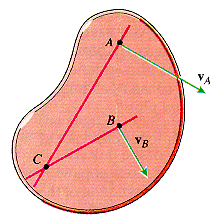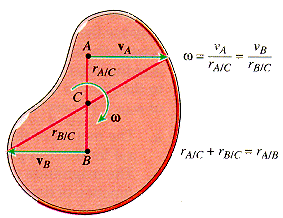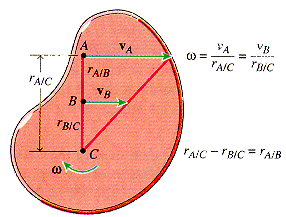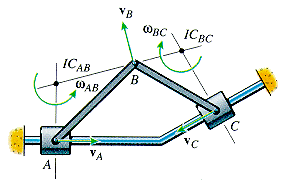General Plane Motion
Absolute Motion
Relative Motion
Relative Velocity
Instantaneous Center of Zero Velocity
This method is not required to solve any particular problem, but it is another way of expressing the relative velocity equation. As a general rule, if the geometry of a problem is simple, then the instantaneous center method will be the easiest to use. However, if the geometry is complex, the the algebraic, relative velocity equations will be the easiest to use.
"Instantaneous Center" of Zero Velocity - a point on (or off) the body that has zero velocity at a specific instant in time
This point generally does not have zero acceleration and will change locations with time.
Let the instantaneous center be located at point C, that is vC = 0. Relative velocity says that we can relate the velocity of any other point to the velocity of point C. Therefore, we can write
![]()
for point A and
![]()
for point B.
From the definition of cross products, we can see that point C must lie on a line through point A that is perpendicular to vA. The same must also be true for vB.
- If vA and vB are not parallel, then the instantaneous center of zero velocity will be at the point of intersection of the two perpendicular lines.

- If vA and vB are parallel and in opposite directions, then the instantaneous center of zero velocity is along the line joining the two points.

- If vA and vB are parallel and in the same direction, then the instantaneous center of zero velocity is along the line joining the two points, with both points on the same side of the instantaneous center.

- If vA and vB are equal, then the body is instantaneously in translation and
= 0. In this case, one can consider the instantaneous center to be located at infinity.
Once the instantaneous center is located, the velocity of any other point in the body can be determined using relative velocity.
![]()
When two or more bodies are pinning together, a different instantaneous center can be found for each body. Since the velocity of the point joining two bodies is the same for each body, the instantaneous center of both bodies must lie on a single line through the common point.

Consider the special case of a wheel (or gear) rolling without slip,

Notice that the instantaneous center is located where the wheel contacts the ground (a stationary object).